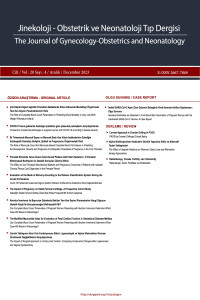The Role of Monocyte Count and Monocyte Based Complete Blood Cell Indexes in Predicting the Development, Severity and Prognosis of Intrahepatic Cholestasis of Pregnancy in the First Trimester
Abstract
Abstract
Aim: To evaluate the effect of monocyte count and monocyte-based whole blood cell indices in the prediction of intrahepatic cholestasis of pregnancy (ICP) in the first trimester.
Materials and Method: The clinical data of patients who presented to the Perinatology Clinic of the Turkish Ministry of Health ----xxxxxxx--- ICP between January 1, 2021, and October 1, 2022, were evaluated retrospectively. Maternal demographic parameters, gestational age at birth, fetal birth weight, first-trimester white blood cell, neutrophil, platelet, monocyte, lymphocyte, and basophil counts, lymphocyte-to-monocyte ratio (LMR), platelet-to-monocyte ratio (PMR), neutrophil-to-monocyte ratio (NMR), and basophil-to-monocyte ratio (BMR) were recorded. These parameters were compared between the ICP and control groups. The relationship between monocyte count, monocyte-based blood cell indices, and fasting bile acid levels was evaluated in the ICP group. The cut-off values of the first-trimester monocyte count and monocyte-based blood cell indices for the prediction of ICP were determined.
Results: Gestational week at birth and fetal birth weight were significantly lower, and the neonatal intensive care requirement was significantly higher in the ICP group (p<0.05) compared to the control group. The ICP group had a significantly higher monocyte count (p=0.002), a significantly lower platelet count (p=0.002), and significantly lower values for monocyte-based complete blood cell indices (NMR, LMR, and PMR) compared to the control group (p=0.005, p=0.001, and p<0.001, respectively).
Conclusion: A high monocyte count and low monocyte-based inflammatory indices measured in the first trimester of pregnancy seem to be associated with ICP. These novel indices can be used in the prediction of ICP and its adverse perinatal outcomes.
References
- 1. Allen AM, Kim WR, Larson JJ, Rosedahl JK, Yawn BP, McKeon K, et al. The Epidemiology of Liver Diseases Unique to Pregnancy in a US Community: A Population-Based Study. Clin Gastroenterol Hepatol. 2016;14(2):287-94.e1-2. Epub 20150821. doi: 10.1016/j.cgh.2015.08.022. PubMed PMID: 26305066; PubMed Central PMCID: PMC4718803. 2. Lee RH, Goodwin TM, Greenspoon J, Incerpi M. The prevalence of intrahepatic cholestasis of pregnancy in a prima- rily Latina Los Angeles population. J Perinatol. 2006;26(9):527- 32. Epub 20060608. doi: 10.1038/sj.jp.7211545. PubMed PMID: 16761011.
İlk Trimesterde Monosit Sayısı ve Monosit Bazlı Kan Hücre İndekslerinin Gebeliğin İntrahepatik Kolestazı Gelişimi, Şiddeti ve Prognozunu Öngörmedeki Rolü
Abstract
Özet
Amaç: İlk trimesterde gebeliğin intrahepatik kolestazının (GİK) öngörüsünde monosit sayısı ve monosit bazlı kan hücre indekslerinin etkisini değerlendirmek.
Gereçler ve Yöntem: Bu çalışmaya 01/01/2021 ile 01/10/2022 tarihleri arasında Sağlık Bakanlığı –xxxxxxxx- Hastanesi Perinatoloji kliniğinde değerlendirilen GİK tanılı hasta grubu (n=65) ve kontrol grubu (n=107) dahil edildi. Her iki grubun laboratuvar testleri retrospektif olarak incelendi. Grupların maternal demografik özellikleri, ilk trimester monosit sayıları ile lenfosit-monosit oranı (LMO), platelet-monosit oranı (PMO), bazofil-monosit oranı (BMO), nötrofil-monosit oranı (NMO) indeksleri karşılaştırıldı. GİK grubunda monosit sayıları ve monosit bazlı kan hücre indeksleri ile açlık safra asidi düzeyleri arasındaki ilişki değerlendirildi. GİK'i öngörmede ilk trimester monosit sayısı ve monosit bazlı kan hücre indeksleri için eşik değeri belirlendi.
Bulgular: GİK grubunda doğum haftası, doğum ağırlığı daha düşük ve yenidoğan yoğun bakım ihtiyacı daha yüksek ve istatistiksel olarak anlamlıydı (p < 0.05). GİK grubunda monosit sayısı daha yüksek (p=0.002), trombosit sayısı daha düşük (p=0.002) ve monosit bazlı tam kan hücre indeksleri sırasıyla NMO, LMO, PMO daha düşük ve istatistiksel olarak anlamlıydı (sırasıyla p=0.005, p=0.001, p<0.001).
Sonuç: Sonuç olarak, gebeliğin ilk trimesterinde daha yüksek monosit sayıları ve düşük monosit bazlı tam kan hücre indeks değerleri GİK ile ilişkili görünmektedir. Bu yeni indeksler, GİK'in ve bunun olumsuz perinatal sonuçlarının tahmininde kullanılabilir.
References
- 1. Allen AM, Kim WR, Larson JJ, Rosedahl JK, Yawn BP, McKeon K, et al. The Epidemiology of Liver Diseases Unique to Pregnancy in a US Community: A Population-Based Study. Clin Gastroenterol Hepatol. 2016;14(2):287-94.e1-2. Epub 20150821. doi: 10.1016/j.cgh.2015.08.022. PubMed PMID: 26305066; PubMed Central PMCID: PMC4718803. 2. Lee RH, Goodwin TM, Greenspoon J, Incerpi M. The prevalence of intrahepatic cholestasis of pregnancy in a prima- rily Latina Los Angeles population. J Perinatol. 2006;26(9):527- 32. Epub 20060608. doi: 10.1038/sj.jp.7211545. PubMed PMID: 16761011.
Details
| Primary Language | English |
|---|---|
| Subjects | Obstetrics and Gynaecology |
| Journal Section | Research Articles |
| Authors | |
| Publication Date | December 31, 2023 |
| Submission Date | April 29, 2023 |
| Acceptance Date | November 13, 2023 |
| Published in Issue | Year 2023 Volume: 20 Issue: 4 |


